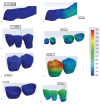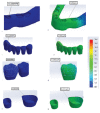A Comparative Three-Dimensional Finite Element Study of Two Space Regainers in the Mixed Dentition Stage
- PMID: 32168538
- PMCID: PMC7069744
- DOI: 10.1055/s-0040-1702254
A Comparative Three-Dimensional Finite Element Study of Two Space Regainers in the Mixed Dentition Stage
Abstract
Objectives: This study aims to compare the stress distribution and displacement that resulted from the use of a Gerber space regainer and sagittal distalizer using three-dimensional finite element analysis.
Materials and methods: Three-dimensional simulated models of the appliances were developed using a software. The forces applied by the two appliances were 3N (tipping) and 15N (bodily), respectively. Displacement and von Mises stress on the compact and cancellous bone, periodontal ligament (PDL), crowns of the mandibular first, second permanent molars, and deciduous canines were calculated. Stress distribution and displacement values were measured via linear static analysis.
Results: Gerber space regainer showed greater displacement than that produced by the sagittal distalizer at the first permanent molar. However, such displacement was less at the other tested points when compared with that delivered by sagittal distalizer. The stresses created by Gerber appliance were higher in the crown and PDL of the deciduous canine than the crown of the first permanent molar crown.
Conclusions: Gerber appliance generates more distal force and less stress concentration on the crown of the mandibular first permanent molar than that created by the sagittal distalizer. On the other hand, stress concentrations produced by Gerber space regainer are found to be more on the crown and PDL of the deciduous canine. Therefore, it can be concluded that the use of Gerber appliance needs more anchorage.
Conflict of interest statement
• Premature loss of deciduous dentition is common and has significant impacts on the growing child including a decrease in the arch perimeter. Therefore, the space regaining is mandatory.• This study simulates two space regainer appliances using a FEM that simulates the clinical situation providing dependable data in a noninvasive way about stress distribution and displacement values in the dentoalveolar structures in mixed dentition stage.• Limited data are available in such an era of pediatric dentistry, so comparing stress concentration and displacement simulation created by two space regainers with different types of tooth movements is viable in the dentist decision and treatment plan for space regaining.None declared.
Figures




Similar articles
-
Comparison of Stresses Generated within the Supporting Structures of Mandibular Second Molars Restored with Different Crown Materials: 3-D Finite Element Analysis (FEA).J Prosthodont. 2015 Aug;24(6):484-93. doi: 10.1111/jopr.12240. Epub 2014 Dec 17. J Prosthodont. 2015. PMID: 25521774
-
Comparative evaluation of displacement and stress distribution pattern during mandibular arch distalization with extra and inter-radicular mini-implants: a three-dimensional finite element study.Dental Press J Orthod. 2023 May 29;28(2):e2321373. doi: 10.1590/2177-6709.28.2.e2321373.oar. eCollection 2023. Dental Press J Orthod. 2023. PMID: 37255133 Free PMC article.
-
[Stress change of periodontal ligament of the anterior teeth at the stage of space closure in lingual appliances: a 3-dimensional finite element analysis].Beijing Da Xue Xue Bao Yi Xue Ban. 2018 Feb 18;50(1):141-147. Beijing Da Xue Xue Bao Yi Xue Ban. 2018. PMID: 29483737 Chinese.
-
Molar distalization with pendulum appliances in the mixed dentition: effects on the position of unerupted canines and premolars.Am J Orthod Dentofacial Orthop. 2006 Mar;129(3):407-17. doi: 10.1016/j.ajodo.2005.12.004. Am J Orthod Dentofacial Orthop. 2006. PMID: 16527638
-
Maximum equivalent stress induced and the displacement of the developing permanent first molars after the premature loss of primary second molars: A finite element analysis.Dent Med Probl. 2020 Oct-Dec;57(4):401-409. doi: 10.17219/dmp/122041. Dent Med Probl. 2020. PMID: 33448165
Cited by
-
Agreement of the Newly Developed Moyers' Equations and Moyers' Tables.Eur J Dent. 2023 Jul;17(3):673-677. doi: 10.1055/s-0042-1749157. Epub 2022 Oct 28. Eur J Dent. 2023. PMID: 36307115 Free PMC article.
-
Influence of the Inclination of the Incisal Edge of Planas Direct Tracks on Deciduous Dentition with Anterior Crossbite: Finite-Elements Study.Eur J Dent. 2022 Jul;16(3):528-535. doi: 10.1055/s-0041-1735435. Epub 2021 Nov 30. Eur J Dent. 2022. PMID: 34847613 Free PMC article.
-
A Three-Dimensional Finite Element Analysis: Maxillary Dentition Distalization with the Aid of Microimplant in Lingual Orthodontics.Int J Gen Med. 2021 Nov 18;14:8455-8461. doi: 10.2147/IJGM.S337212. eCollection 2021. Int J Gen Med. 2021. PMID: 34824544 Free PMC article.
-
Effects of maxillary molar distalization using clear aligners during the mixed dentition and early permanent dentition with 3 types of Class II traction: a three-dimensional finite element analysis.BMC Oral Health. 2025 May 14;25(1):717. doi: 10.1186/s12903-025-06119-7. BMC Oral Health. 2025. PMID: 40369496 Free PMC article.
-
Pediatric Stainless-Steel Crown Cementation Finite Element Study.Eur J Dent. 2021 Feb;15(1):77-83. doi: 10.1055/s-0040-1715915. Epub 2020 Oct 1. Eur J Dent. 2021. PMID: 33003242 Free PMC article.
References
-
- Klapper B J, Strizak-Sherwin R. Esthetic anterior space maintenance. Pediatr Dent. 1983;5(02):121–123. - PubMed
-
- Barbería E, Lucavechi T, Cárdenas D, Maroto M. Free-end space maintainers: design, utilization and advantages. J Clin Pediatr Dent. 2006;31(01):5–8. - PubMed
-
- Law C S. Management of premature primary tooth loss in the child patient. J Calif Dent Assoc. 2013;41(08):612–618. - PubMed
-
- British Society of Paediatric Dentistry . Rock W P. UK National Clinical Guidelines in Paediatric Dentistry. Extraction of primary teeth – balance and compensation. Int J Paediatr Dent. 2002;12(02):151–153. - PubMed
LinkOut - more resources
Full Text Sources

